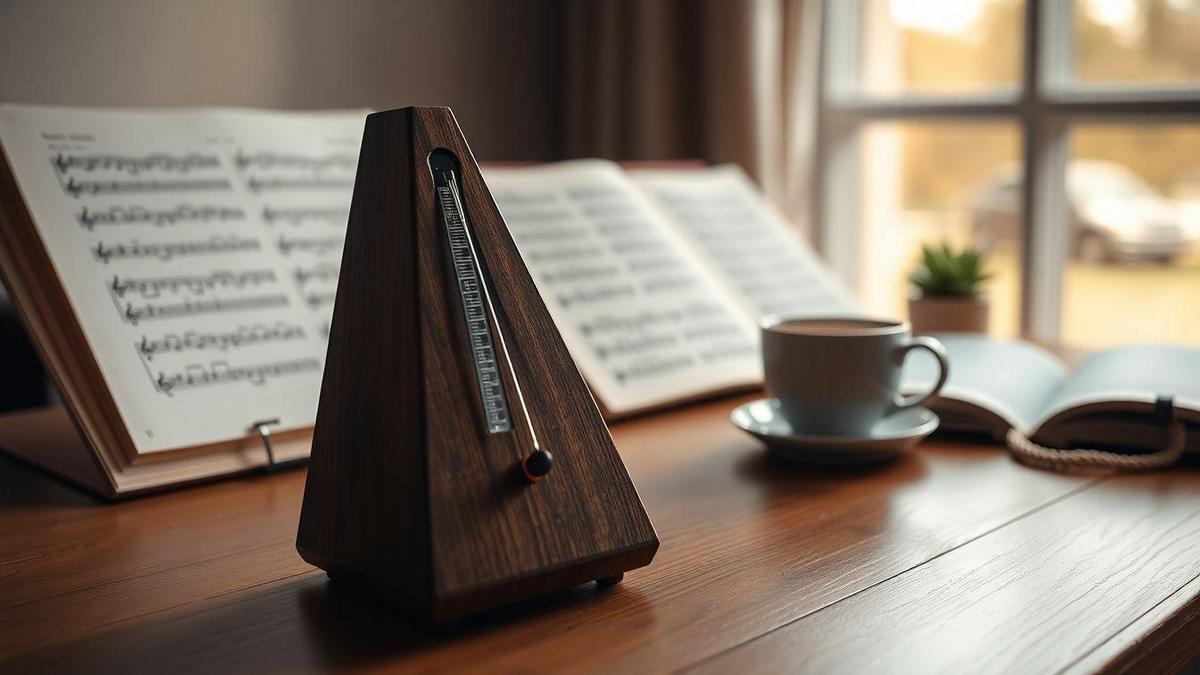How to use a metronome without losing patience
I’ll show a calm, step-by-step system I use to build steady timing and keep practice pleasant. The short version: start very slow, feel the pulse, breathe with the click, practice in short bursts on tiny chunks, raise tempo in tiny steps, and test accuracy before you speed up. This article—How to use a metronome without losing patience—gives practical drills, short practice blocks, and a patient plan to make rhythm easier. If you like structured sessions, pair these ideas with a simple daily practice routine to keep steady progress.
Key takeaway — How to use a metronome without losing patience
- Start the metronome so slow you can’t fail.
- Practice tiny chunks (1–4 bars) in 5–12 minute bursts.
- Breathe with the click and count subdivisions.
- Raise tempo by 1–2 BPM (never big jumps).
- Record, log, and celebrate small gains — a few tips for staying on track are covered in staying motivated when progress feels slow.

Slow practice: feel the pulse
Slow practice makes micro-timing audible and finger movement honest. See structured short practice and slow practice from Berklee.
- Pick a 2–4 bar unit and set a crawl tempo where every note is comfortable.
- Play it repeatedly until the downbeat and last beat feel anchored.
- If the pulse slips, slow more; if it holds, raise the tempo slightly.
Practical steps:
- Choose a tiny unit (1–4 bars).
- Play 3–6 clean repeats at a very slow tempo.
- Mark downbeats with a tap or hum to anchor yourself — pairing this with a short ritual can help; see rituals that help you enter practice mode.
Start very slow with the metronome
Treat the metronome like a slow walking partner—boring is good.
- Set a tempo you can play perfectly three times in a row.
- Turn the click volume down if it annoys you.
- Use subdivisions only when you need them.
Progress routine:
- Play 3 perfect repeats → increase by 1–2 BPM → repeat.
- If mistakes appear, drop back to the last clean tempo.
If you prefer compact daily blocks, combine this with the ideas in the power of just twenty minutes daily to keep sessions short and effective.
Short sessions and tiny chunks
Short bursts preserve focus and patience.
- Work in 5–12 minute bursts, repeating the same small part 6–12 times.
- Rest 2 minutes between bursts.
- Warm up 2–3 minutes, then do one focused burst.
Example routine:
- Warm up (2–3 min)
- Focused burst on one unit (5–8 min)
- Short break (2 min)
- Repeat, raise tempo only when clean
This approach pairs well with a simple practice structure and the short-session ideas from twenty-minute practice plans.
Gradual tempo increase — one step at a time
Climb stairs, don’t leap.
- Increase by 1 or 2 BPM for most passages; avoid jumps >5 BPM.
- If 1 feels tiny, change subdivision (e.g., use half-time or double-time) to adapt the ear without pressure.
- Treat each tempo as a mini-goal, not a race.
Rule of thumb: three clean repeats at the current tempo before moving up.
If procrastination or impatience is a recurring issue, the strategies in how to stop procrastinating on music practice can help you stick to tiny tempo steps.

Looping and joining chunks
Loop 2–4 beats to isolate trouble spots and then glue pieces together slowly.
- Loop the trouble window until it locks in with the click.
- Play chunk A five times, chunk B five times, then AB slowly until the join is solid.
- Only move on when you can play the join three times perfectly.
When you need to glue melodic fragments or transitions, the mindset from writing your first melody without overthinking helps make joining feel natural instead of forced.
Breathe with the click — mindful metronome training
Breathing makes the click human and calms tension—a core part of How to use a metronome without losing patience.
- Set metronome to 60–80 BPM.
- Inhale on beat 1, exhale across beats 2–4 (or match a pattern that fits your phrasing).
- If frustrated: stop, hands down, take a deep breath (e.g., inhale 4, hold 2, exhale 6), then resume at a slower tempo.
For step-by-step breathing techniques, try breathing exercises to reduce performance tension.
Quick reset:
- Stop and breathe.
- Lower click volume or slow tempo 10–20%.
- Play one short, easy phrase with the click.
A few simple pre-practice rituals can make this breathing technique stick—see rituals that help you enter practice mode.

Subdivide and count to stay patient
Subdivisions turn a cold click into a map of the beat. See practical rhythm and subdivision exercises.
- Clap or count subdivisions (eighths, triplets, sixteenths) to internalize the inner pulse.
- Alternate between vocal counting and silent counting to check internalization.
Drill example:
- 2 min: quarters, play a chord on each beat
- 2 min: eighths (“1 & 2 &”), single notes
- 2 min: sixteenths (“1 e & a”), slow riff
- 1 min: mute metronome, keep counting internally
If you want to deepen your ear and internal pulse, try some interval recognition drills or revisit scale-based exercises to make subdivisions feel musical rather than mechanical.
Record, review, and plan
Recording removes excuses and shows real timing issues. Read about the role of deliberate practice and feedback.
- Record a take with the metronome audible or align the clip to a click grid.
- Listen for consistent patterns of rush/lag and mark timestamps.
- Plan one or two targets for the next session.
Use slow-motion and looping in your DAW:
- Loop the exact bar (1–4 bars), slow to 50–70%, fix, then raise tempo back in small steps.
Pair recordings with a short session plan from simple practice routines to turn observations into consistent improvement.
Gamify progress and keep a practice diary
Making practice a game keeps the metronome friendly.
- Set small goals (3-minute rounds, 10 clean reps).
- Celebrate tempo or accuracy milestones with tiny rewards.
- Keep a one-line diary: date, passage, start BPM, goal BPM, clean reps, short note.
Example diary entry:
- 2025-09-12 — Verse riff — 78 → 84 BPM — 10 clean reps — click steady, hand relaxed
If keeping practice fun is a struggle, making practice fun instead of a chore has practical ideas for gamifying sessions.

Endurance and reps — increase gradually
Build rhythm stamina like fitness: small, consistent increases.
- Warm up 2–3 minutes at slow tempo.
- Play a pattern 8 times, rest 30–60 seconds, repeat 3–5 cycles.
- Each session add 1–2 repeats or 10–20% more time, not huge jumps.
Track simple metrics: BPM where pattern stays steady, repeats before fatigue, comfort level (1–5). For guidance on daily time and sustainable increments, see how much time per day for music.
Switch tasks when concentration drops
If you lose focus, switch to a fresh task (ear training, a favorite riff, chord changes) for 2 minutes and come back. Treat switching as strategy, not quitting. Short mental resets and motivation tips can be found in staying motivated when progress feels slow.
Practical checklist before increasing tempo
- Play the unit three clean times in a row.
- Record one take and listen for slips.
- Count or sing the rhythm while playing—if your voice races, slow down.
- Only then increase by 1–2 BPM.
For session templates that include checklists like this, review simple daily practice routines.
Conclusion — How to use a metronome without losing patience
Keep it simple: start very slow, feel the pulse, breathe with the click, practice in short bursts on tiny chunks, and raise tempo by tiny steps only after testing accuracy. Treat the metronome as a coach, not a judge—loop trouble spots, record and log progress, and reward small wins. If you want compact, repeatable session ideas that use these principles, consider short daily practice plans or explore more ways to keep practice engaging at making practice fun. Follow these steps and your timing will tighten without wearing out your patience.
For more step-by-step tips and short practice plans, visit https://clickneutro.com.

2 comentários em “How to use metronome without losing patience”